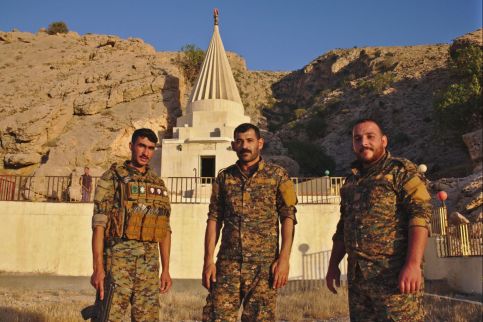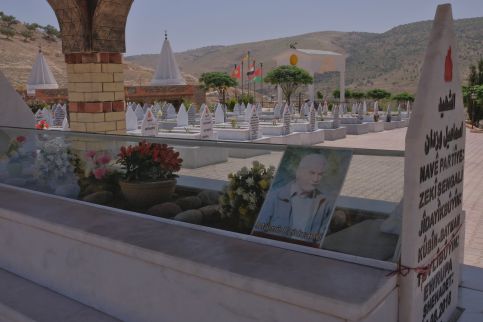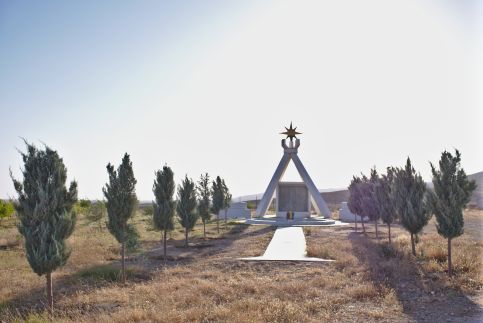Zoroastrianism and Secularity in Sinjar
By Benjamin Raßbach
The PKK (Kurdistan Workers' Party) has always presented itself as a non-religious political party, fighting for Kurdish self-determination within a broad region defined as Kurdistan. Though he initially took a stance that was clearly anti-religious, the party's leader Abdullah Öcalan’s approach to religious communities warmed from the beginning of the 1990s. At that time, he began to adjust his extensive writings towards a specific interpretation of the history of religion in the Middle East. By describing the monotheistic traditions of Judaism, Christianity and Islam as essential driving forces of history, he implicitly offered reconciliation to Kurdistan's Muslims. However, as some of the party's (potential) followers belonged to other religious communities – and often took an explicitly anti-Islamic stance – he also offered corresponding theories on their behalf. Among these groups, the Kurdish-speaking Yezidis in Iraq and Syria, as well as the Alevis of Dersim in Turkey, stand out for their relatively high numbers. Thus, the PKK founded Alevi and Yezidi organisations to build an ideological bridge to these groups. However, in line with an older Kurdish-nationalist tradition, Öcalan also lauded Zoroastrianism as the "original" Kurdish religion, of which the Yezidis, and sometimes other communities, are presented as direct descendants. Today, however, most Yezidis in Iraq reject this claim.
During the genocide against the Yezidis and other groups, committed by ISIS in 2014, the PKK was the only regional military power that assisted the civilian refugees sheltering in the mountainous uplands of Sinjar, northern Iraq, seeking to protect them from the Jihadists' attacks. Without the PKK and its local allies' help, the number of casualties would have been much higher. As a result, the party gained considerable influence in the Sinjar region, which it still exerts today. The PKK is by no means the only powerful player in this strategically important border region, however: Three other militias are also present in the area, respectively supported by Iran, the Iraqi central government, and the Kurdistan region of northern Iraq. The tension between these forces is palpable, and everybody expects clashes to break out sooner or later, again most deeply affecting the local civilian population.
Large parts of Sinjar's infrastructure remain unrepaired; buildings destroyed by explosives or airstrikes still scatter the landscape – a situation preventing many of the refugees from returning to their homes. It is noticeable, however, that the area’s religious architecture has received considerably more attention to its needs in recent years than has been the case in any other field. The most obvious example is the large Shi’a shrine, Sittî Zeynab, which towers above the city of Sinjar. Before the ISIS attack, the shrine was mainly frequented by the local Shi’a Kurdish population, whose beliefs differ considerably from the Twelver Shi’a official state religion of Iran which is also dominant in large parts of Iraq. Following their conquest of the city on 3 August 2014, the shrine was immediately destroyed by ISIS. After Iranian-supported militias reconquered large parts of the southern Sinjar region, the Iraqi government extensively rebuilt the Sittî Zeynab shrine, somewhat in contrast to the rest of the Yezidi-majority city - particularly the traditional neighbourhood surrounding it, that had been completely destroyed.
The PKK and its allies have also been responsible for constructing sacred sites – or, put more tentatively, employing sacral architecture – at several locations within Sinjar. Traditional Yezidi shrines, destroyed by ISIS, have been rebuilt in line with the unified architectural style widely used for them today. The shrine of Sheykhê Mahamma in Barê, western Sinjar, is one such example. In the first room of the building, a picture of a "martyr" is displayed, perhaps serving as a reminder to pilgrims of who liberated this area from ISIS.

Near the village of Karsê, the same groups constructed a "martyrs' graveyard", in which the graves of hundreds of fighters who were killed by ISIS can be visited. A building closely resembling a Yezidi shrine forms its entrance. Entering this building, the visitor is greeted not by a cenotaph or a variety of objects used for luck-promising rituals, as would be the case in many traditional Yezidi shrines. Instead, an otherwise empty room shows hundreds of pictures of deceased fighters, and offers a book in which messages can be left for others to read. Visitors are not encouraged to take off their shoes, nor to observe any particular religious prescriptions, nonetheless the mere shape of the building clearly gives the graveyard a sanctified aura. After stepping outside and entering the graveyard itself, two other constructions meet the eye. The first is a roof sheltering two small peacock statues, which face each other. The peacock represents Tawsî Melek, the most important Yezidi angel and, as such, a symbol of the community.
The second construction, situated on the opposite side of the graveyard, sports a similarly elaborate roof. This one covers the grave of Zekî Şengali, a man widely revered across demographic groups in Sinjar, not only by supporters of the PKK and its allies. He started his career as a PKK activist in Germany, later moving to the guerrilla zones of Qandil, the site of the PKK headquarters in northern Iraq. Over the following decades, he rose to become both the most important Yezidi leader within the PKK, and the PKK leader that exerted the most influence over the Yezidis of Sinjar. He was killed by a Turkish airstrike on 15 August 2018, after attending a memorial for the anniversary of the Kocho massacre - one of the worst mass killings during the genocide against the Yezidis. 
Some visitors respectfully take off their shoes when approaching Şengali’s grave – an act normally reserved for private homes and sacred places. The structure itself carries a symbol which calls to mind, though somewhat ambiguously, the Zoroastrian Faravahar, as well as a sun, and the shrine of Sheykh Adi in Lalish – all at once. It clearly makes reference to the Yezidi tradition, while at the same time hinting at its supposed Zoroastrian background.
A second monument, close to Barê in western Sinjar, commemorates the site of Şengali’s death. The monument was built in a modern, abstract style, but it is clearly designed to remind Yezidis of a Qob - the most common form of a Yezidi sacred place.

Zekî Şengali's reputation as a mediator between the Kurdish revolutionary organisation and the conservative Yezidi society has melted into anecdotes and stories, particularly since his death.
A representative of PADÊ, an official Iraqi party close to the PKK, told me one of them: Once, an old Yezidi man asked Zekî: "Are we now [that you have taken power in Sinjar] obliged to marry our girls to your fighters?"
Zekî answered: "Of course not, our fighters are Muslims!"
But the man replied: "No, your fighters are not Muslims, they are Apocu [i.e. followers of PKK leader Abdullah Öcalan]." The same representative also told me: "For Yezidis, the PKK stands beyond particular religions. It is regarded as a power defending all religions because it invokes Zoroastrianism."
Zoroastrianism often is thought of in this context as a straightforward philosophy, amounting to 'think rightly, speak rightly, act rightly…', rather than as a particular religious tradition. In recent years, Zoroastrianism has been "reclaimed" by many Kurds of Muslim background, with a number of temples being opened in Iraqi Kurdistan. However, this form of neo-Zoroastrianism doesn't bear many similarities to traditional forms of this religion, as practiced in Iran and India today.
Used in reference to the PKK, the terms 'Apocu' and 'Zoroastrian' are thus discursively constructed as two sides of the same coin. The PPK is then envisioned as a secular, military power, able to unify all Kurdish-speaking populations. This composite identity is seen in its perception as being a non-religious actor, whilst at the same time representing the "original" Kurdish religion - or at least its remains. Zekî himself, in the apocryphal account cited above, gives a reflection of how thorny this question actually is. Though himself a Yezidi, Zekî calls his fighters "Muslims", which – contrary to the stance taken by the old man in the story – reflects how the PKK and its allies are generally viewed by Yezidis in Sinjar. The fact that many of these fighters are themselves Yezidis doesn't affect this attitude at all. Originating from the Muslim-majority Kurdish region in Turkey, most PKK members in the wider region of Kurdistan come from Muslim families.
It is well known that Yezidis are a so-called ethno-religious community, which in this case means that marriage outside the community is severely sanctioned. Zekî, showing his awareness of the fact that the PKK is regarded as "Muslim" by the Yezidi majority, thus politely declines the old man's offer – which was, most probably, itself made purely out of politeness. The possibility of Yezidi women marrying non-Yezidi PKK fighters is not regarded a serious option.
In Sinjar, the places that commemorate Zekî Şengali and other "martyrs" can be understood as attempts to make symbolic reference to traditional Yezidi sacred places - and are thus attributed a certain sanctity of their own. At the same time, they are – somewhat pejoratively – understood as representing a political party, which for decades has been trying to construct a secular image of itself, while being clearly regarded as Muslim in the Alevi-majority region of Dersim, as well as in Sinjar and other regions with a non-Muslim majority. This confusion is somewhat rooted in the varying conceptions of religious, ethnic, and political identity. While for the Yezidis there is no difference between the categories of ethnicity and religion, the PKK and its allies tend to emphasise the unity of ethnic identity and politics over religious affiliation.
A further sacral site in Sinjar is the "Martyrs’ Garden", an area displaying some lawns and many concrete imitations of wooden constructions. A mountain goat, a white peacock and a lion vegetate in their individual cages. The garden is used as a social gathering point for young people and families in the cool hours of the evenings, while newly-wed couples come to take photos. Towards the centre of the gardens, there is an artificial cave, in which the casual visitor finds a fireplace seeming to lack any practical function. The place is vaguely reminiscent of a Zoroastrian fire altar, but does not seem to have a ritualistic purpose, either. Ultimately, the cave’s purpose seems to be purely aesthetic, unlike Zekî Şengali's grave and the Martyrs' Graveyard, whose statuses as sacred places seem at least ambiguous.
The Martyrs' Garden was bombed by the Turkish Air Force a couple of years ago, allegedly because pictures of fighters killed by ISIS were displayed along the main path through the garden. The site was later reconstructed, this time without the pictures. It thus seems reasonable to ask why the Martyrs' Garden was bombed, while the Martyr's Graveyard – which is just a few kilometers down the road – was spared. Is it possible that, while its sacralised places still have not found wide recognition among the Yezidis in Sinjar, the PKK managed to persuade the Turkish state of the Martyrs' Graveyard’s sacred nature, and that it must not be bombed because of its religious significance for the Yezidi community?
Sacred space is a marker of territoriality not only in Sinjar. A sacred place defended against or reconquered from ISIS produces the legitimate claim to a certain territory. At the same time, however, territories are claimed by new sacralising markers in the landscape. There are certain rules in the Yezidi religion, which in most cases forbid the construction of new sacred places. Within the Yezidi discourse in Sinjar, these rules create a powerful symbolic boundary between "the political" and "the religious" with regard to such markers. Although exceptions to those prescriptions abound, this separation is often used to denigrate the meaning of a certain place, referring to it as "just political" or "just belonging to a party". This criticism is sometimes further extended to include and reflect on the political group associated with the place. This often happens in discussion of the PKK's shrine-like structures. It is important to note, though, that the PKK and its allies have never openly claimed these places to be sacred in the traditional Yezidi sense. Contrary to the way a concrete demarcation between political and religious things is continuously asserted by Yezidi religious authorities and most traditionalists, on closer inspection this line seems rather fine and fluid. Regarding the grave of Zekî Şengali, it seems very possible that, in time, it will become a true sacred place, complete with a shrine. And wouldn’t it be an irony, if Turkey were then among the first to implicitly recognise these places as sacred?
Benjamin Raßbach is currently working on a dissertation project on Religious and political Mythologies of Sacred Spaces in Kurdistan, supervised by Markus Dreßler at Leipzig University. In his blog Kritik und Imagination he shares impressions from his last visit to the Sinjar region this summer.


